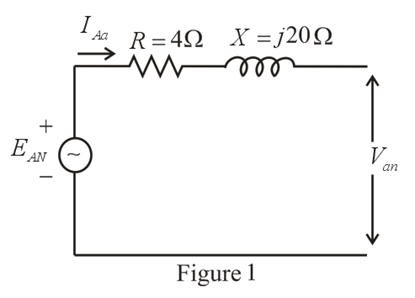
The Y-Y system in Fig. 24.53 has a balanced load and a line impedance
a. The magnitude of each phase voltage of the generator.
b. The magnitude of the line currents.
c. The total power delivered by the source.
d. The power factor angle of the entire load "seen" by the source.
e. The magnitude and angle of the current if
f The magnitude and angle of the phase voltage Van
g. The impedance of the load of each phase in rectangular coordinates.
h. The difference between the power factor of the load and the power factor of the entire system (including Zline.
i. The efficiency of the system.

Want to see the full answer?
Check out a sample textbook solution
Chapter 24 Solutions
Laboratory Manual for Introductory Circuit Analysis
- NO AI. Please draw CT's on figure with directionarrow_forward15) Complex numbers 21 and 22 are given by Δ Δ Δ Z₁ = 21-60° 22 = 5/45° Determine in polar form: Z, Z₂ b) 21/22 Z₁ C) Z, Z₂ dz 2 zz Z f) JZ ₂ 9) z, (z₂-z₁) * ~22/(Z1+Zz) FAAAAAA Aarrow_forwardform: Express The following Complex numbers in rectangular № 2, b) Z₂ = -3e-jπ/4 c) 23 = √ 3 e d 24 11 -j 25 = ==J 3 -4 2 -j3π/4 f) 26 = (2 + j) 9) 2₂ = (3-j2)³ g D 27 AAA D A 35arrow_forward
- 0) Express The following complex numbers in polar form: az₁ = 3+ j4 2 b) 2₂ = -6+j8 C) 23 = 6j4 Z4=j2 d) 24 = j2 e) 25 = (2+ j)² 3 4) 26 = (3-j2) ³ JZ7 = (1+j) ½/2 27 D D D D D AA D AALarrow_forward21) Determine. The phasor counterparts of the following sinusoidal functions: (a) V₁ (t) = 4 cos (377-30°) V (B) V₂ (t) = -2sin (8T x 10"+ + 18°) V e) V3 (t) = 3 sin (1000 + + 53°)-4c05 (1000 t -17°) v AAA AAAAAarrow_forwardI need help with this problem and an explanation of the solution for the image described below. (Introduction to Signals and Systems)arrow_forward
- Tutorial - Design of Common-Gate (CG) Amplifier Design a common-gate NMOS amplifier with the following parameters: Supply Voltage (VDD): 10 V ⚫Threshold Voltage (Vth): 2 V •Overdrive Voltage (Vov) = VGS-Vth: 1 V • Desired Voltage Gain Av: 10 V/V • Transconductance gm: to be determined •Ensure that the NMOS operates in the saturation region. ⚫ Design Vos to ensure saturation and enough voltage swing. C₁ Vin +VDD RD C₂ V out Rs WI RLarrow_forwardNEED HANDWRITTEN SOLUTION DO NOT USE CHATGPT OR AIarrow_forwardDetermine the response y(n), n≥0 of the system described by the second order difference equation: y(n)-4y(n-1)+4y(n-2)=x(n)-x(n-1) when the input is x(n)=(−1)" u(n) and the initial conditions are y(-1)=y(-2)=0.arrow_forward
- Consider a Continuous- time LTI System described by y' (+)+ nycH) = x() find yet for a) x(+)o ē+4(H) b) X(+) = u(+). c) X(H= 5(+)arrow_forwardFind the Thevenin equivalent representation of the circuit given to the left of the nodes a and b. Find Vth and Rth and draw the equivalent Thevenin circuit. For Rth use a 1 volt test source as your method.arrow_forwardR(s) + E(s) 100(s+2)(s+6) s(s+3)(s+4) C(s)arrow_forward
 Power System Analysis and Design (MindTap Course ...Electrical EngineeringISBN:9781305632134Author:J. Duncan Glover, Thomas Overbye, Mulukutla S. SarmaPublisher:Cengage Learning
Power System Analysis and Design (MindTap Course ...Electrical EngineeringISBN:9781305632134Author:J. Duncan Glover, Thomas Overbye, Mulukutla S. SarmaPublisher:Cengage Learning
